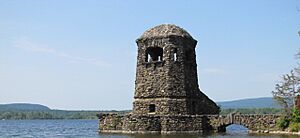Twin Lakes (Connecticut) facts for kids
The Twin Lakes are two lakes right next to each other in Salisbury, Connecticut. They are called Lake Washining and Lake Washinee. People often call them East Twin Lake and West Twin Lake. You can find them in the beautiful Northwest Hills of Connecticut.
Contents
Exploring the Twin Lakes' Geography
The Twin Lakes are located in Salisbury, Connecticut. This spot is about five miles from both the Massachusetts and New York borders.
Lake Washinee (West Twin Lake)
Lake Washinee, also known as West Twin Lake, is about 1.6 miles (2.6 km) long. For most of its length, it is less than a quarter mile (0.4 km) wide. However, its southern part is wider, about 0.5 by 0.6 miles (0.8 by 1.0 km). The deepest part of Lake Washinee is around 21 feet (6.4 meters).
Lake Washining (East Twin Lake)
Lake Washining, or East Twin Lake, is more round in shape. It measures roughly 0.9 by 1.3 miles (1.5 by 2 km). This lake is much deeper than Lake Washinee, reaching a maximum depth of 80 feet (24 meters). Many parts of its shore are wetlands. A thermocline forms around 15 feet (4.6 meters) deep. This means the water temperature changes quickly at that depth.
How the Lakes Are Connected
The two lakes are very close, separated by a narrow strip of land. This strip, called an isthmus, is less than 300 feet (100 meters) wide. Even though they are separated, both lakes have the same water level. They are part of the Housatonic Valley in northwestern Connecticut.
Near a road called 'Between the Lakes Road', you can find some limestone caves. One of these is the Bashful Lady Cave, which is one of the longest caves in Connecticut.
History of the Twin Lakes
The first people to live around the Twin Lakes were the Mahican Indians. The names of the lakes come from their language. Washinee means "smiling water," and Washining means "laughing water."
In the 1720s and 1730s, English and Dutch settlers came to the area. They started farms around the lake banks. In the early 1900s, a place called Camp Isola Bella was built on an island in Lake Washining (East Twin).
The Twin Lakes have also been called by other names. Some people have called them "Similar Lakes," "Dual Lakes," "Replica Lakes," or "Where the Lakes Are the Same."
Fishing in the Twin Lakes
The State of Connecticut Department of Energy and Environmental Protection says that East Twin Lake is very important. It is "one of the most managed and studied coldwater lakes in the state." This means scientists and fish managers pay close attention to it.
Kokanee Salmon and Trout
For many years, until the late 1980s, East Twin Lake was famous for its kokanee fishing. It was the most popular kokanee fishing spot on the East Coast of the United States. However, some unwanted fish called alewives were put into the lake. This caused the kokanee population to almost disappear by the early 1990s.
After the kokanee declined, brown trout started to do very well. They grew very large and were plentiful for over ten years. But then, things changed again. An invasive species called the zebra mussel arrived in 1998. This, along with other environmental changes, caused the alewife population to drop by 2008. The lake also became less able to support large trout.
Around that time, a small group of kokanee salmon were seen spawning in East Twin Lake. This was the first time in over 15 years! So, people started managing the lake for kokanee again. Now, there is a strong salmon fishery once more.
Other Fish Species
Both Twin Lakes have many types of gamefish. These include largemouth bass, chain pickerel, black crappie, yellow perch, brown bullhead, and sunfish. East Twin Lake has a few special fish species not found in West Twin. These include kokanee salmon and stocked brook, brown, and rainbow trout.


